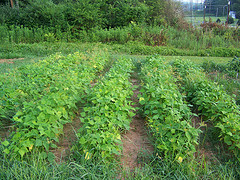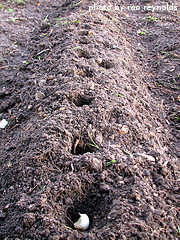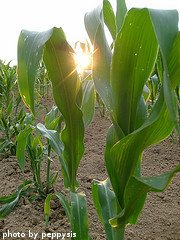Creating a Vegetable Garden Plot?
Just follow our step-by-step guide to creating a vegetable garden from scratch. We will cover topics including...
- Site Selection Considerations
- Size considerations
- Soil Preparation
If you are putting in a vegetable garden plot from scratch and have never done it before, you probably have many questions. How big should I make the garden? What tools do I need? How deep should I dig? Sit back and relax. We've got some answers for you.

The first step in creating a vegetable garden is site selection. The most important factor in selecting the right garden site is sunlight. You need a spot that gets a minimum of 5-6 hours of direct sunlight daily. Ideally, your garden should be created on a flat spot of land. Sometimes this is not possible. A gentle slope is ok. If you have the choice between a shady, flat spot or a sunny location on a slope, always choose the sunny spot on the slope. Additionally, you don't want to choose a location that is at the bottom of a slope. Water runs downhill and your nice, sunny, flat garden plot might be flooded before spring is over. Also, try and choose a spot that is far enough away from large trees. If you start digging up your yard and run into a bunch of thick tree roots, you are too close to the tree and should think about creating a vegetable garden a different location. Have a good spot in mind? Great. We'll move on to the next step in a moment. If you have surveyed your property and determined that no good site exists for creating a vegetable garden, you still have options -
you can always plant a container garden.

The next consideration in creating a vegetable garden is size. How big do you want your garden to be? Your answer to this question depends on a lot of things. How much land is available? How much time and effort do you want to put into your garden? What types of vegetables/fruits do you want to grow? How many plants do you want to grow?
Creating a vegetable garden plot from scratch will require a fair amount of physical exertion - digging, tilling, raking, bending, etc... If you've never had a vegetable garden in the past, start with a small one - maybe 100-200 square feet. Go through the steps outlined below to create a vegetable garden of this size. If you have more land available, you can always add to it and make it as big as you want/need to. If you have some plants in mind that you definitely want to grow, you can now check out the individual vegetable links listed in the navigation bar on our
Home page for information about space requirements for each type of plant.

Or you can go ahead and follow the steps below to create a small garden. Once you have created a vegetable garden plot, you can then choose what you want to grow.
OK, so you've picked the perfect spot. Now you're staring at a plot of land that probably has grass or other plants already growing on it. So how do we transform that spot into a vegetable garden plot? This is the soil preparation part and will require some physical exertion. But there is good news - once completed, you won't ever have to do this much work again to get your garden ready to plant. For this process, you'll need access to a shovel, a garden rake and a tiller. The shovel should have a pointed tip. The garden rake should have short, fixed tines (unlike the long flexible tines of a leaf rake). Tillers come in a wide variety of sizes. You need a tiller that goes at least 6 inches deep. You don't necessarily have to go out and buy an expensive tiller. You can rent one, borrow one or hire somebody to do the tilling part for you. However, if you have the means, owning your own tiller can be cost effective in the long run and much more convenient.
- Use a stick, rock, stake, etc... to mark the corners of the garden plot
- Dig up the land... push the shovel into the ground up to the hilt (stand on it if you have to). Pry up the chunk of earth with the shovel and separate it from the rest of the ground. Turn the chunk of earth upside down and put it grass down into the hole you just created. Repeat this process until your entire plot is dug up. It's important to remember to dig as deep as your shovel will allow. If you only dig a few inches deep now, your garden will under-perform later.
- Run the tiller over the garden plot, using it to break up the large chunks of dirt. Do this several times. Don't worry about deep tilling at this point. Your goal right now is just to break up the chunks of earth you dug up.
- After you've broken up as many chunks as you can with the tiller, it's time to pick out the remaining "unbreakable" chunks. You can pick up the big chunks that are left by hand. Use the garden rake to clear out the remaining smaller chunks, rocks and plant debris.
- Till again. Run the tiller over the garden several times, going deeper each time. Use the rake or your hands to get rid of any remaining rocks or plant debris that pop up. Till again. Till as deep as the tiller will allow. The deeper you till, the better your garden will perform and the easier it it will be to plant.
At this point, the soil should be relatively fine in texture - no big chunks, rocks or plant debris. You should be able to dig down 6 inches or so easily with your bare hands. Now the hardest part is over. As long as you continue to pull the weeds and till right before it freezes in the fall, you won't ever have to do any more major digging (at least for this plot of land).
Congratulations! You've created a vegetable garden plot from scratch. Feels pretty good, doesn't it?
There are only two more factors to consider when planning your garden...plant selection and position.
Click here for the guide to plant selection and positioning (you're almost done!)
Click here to leave the Creating a Vegetable Garden page and return to the main Garden Planning page
Click here to return to our Home page
Create, Prep and Plan Quick Links
Creating Garden From Scratch
Soil Preparation
Plant Selection and Position
Container Garden Planning
Container Plant List
Garden Planning Main Page
Home Page